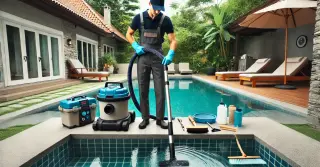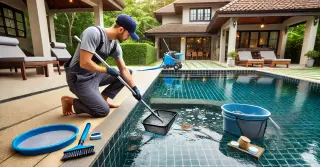Pool Chemical Balance Maurepas LA

Keeping your pool's chemical balance in check is essential for a safe and enjoyable swimming experience. Proper chemical levels prevent the growth of algae and bacteria, keep the water clear and clean, and protect the pool's surface and equipment.
- Balancing pH Levels: The pH balance in your pool reflects its acidity or alkalinity. The ideal pH range is between 7.2 and 7.6. Low pH levels result in acidic water, causing skin irritation and equipment corrosion. High pH levels make the water alkaline, leading to cloudiness and scaling. Regularly testing and adjusting the pH levels is crucial for comfort and safety.
- Monitoring Chlorine Levels: Chlorine plays a crucial role in pool sanitation, as it kills bacteria, algae, and other harmful microorganisms. The proper chlorine level is between 1-3 ppm. Insufficient chlorine results in unsanitary conditions, promoting bacteria and algae growth. Too much chlorine can cause skin and eye irritation and cause a strong chlorine smell. Consistently monitoring and adjusting chlorine levels maintains sanitation and comfort.
Balancing AlkalinityTotal alkalinity is a crucial element of pool chemistry. Alkalinity buffers pH levels, avoiding sudden pH changes. The ideal range for total alkalinity is between 80-120 ppm.
- Avoiding pH Fluctuations: Proper alkalinity levels help stabilize pH levels, preventing rapid changes that can cause skin irritation and damage to pool surfaces. If alkalinity is too low, pH levels can fluctuate wildly, making it difficult to maintain a consistent balance. High alkalinity causes cloudy water and scaling. Regularly testing and adjusting alkalinity levels is essential for maintaining a stable and balanced pool.
- Calcium Hardness Control: Calcium hardness measures the dissolved calcium in water. The ideal range for calcium hardness is between 200-400 ppm. If calcium levels are too low, the water becomes corrosive, damaging pool surfaces and equipment. If calcium levels are too high, it can cause scaling on pool surfaces and cloud the water. Regularly testing and adjusting calcium hardness is crucial for safeguarding your pool and maintaining clear water.
Using Pool Chemicals SafelyHandling and storing pool chemicals properly is crucial for safety and efficiency. Keep chemicals in a cool, dry location, away from direct sunlight and out of reach of children and pets. Adhere to manufacturer guidelines for correct dosing and application.
- Proper Chemical Measurement and Mixing: Precise measurement of pool chemicals is essential to maintain the proper balance. Using too much or too little can disrupt the chemical balance and affect water quality. Always use a clean, dry measuring tool and avoid mixing chemicals directly. Mix in water as needed, following guidelines carefully.
- Awareness of Chemical Reactions: Certain chemicals can react dangerously if mixed. For example, chlorine and acid should never be mixed. Knowing these interactions avoids accidents and ensures safe use. Store chemicals separately and handle each with care to avoid dangerous reactions.
Maintaining the proper chemical balance in your pool is vital for a safe, clean, and pleasant swimming experience. By frequently testing and balancing pH, chlorine, alkalinity, and calcium, you ensure optimal water quality.
Safe use and storage of pool chemicals improve the safety and longevity of your pool.




